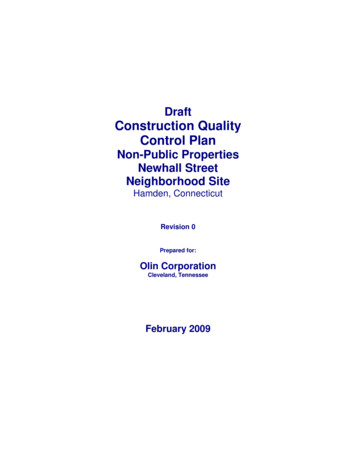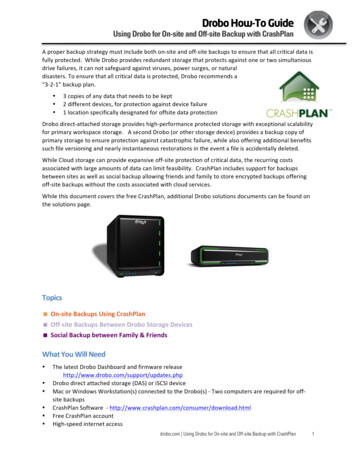
Transcription
On-site Quality Control of BeerQuantification of Isohumulonesand Reduced Isohumulones Usingthe Agilent 1220 Infinity Mobile LCSolutionApplication NoteFood Testing & AgricultureAuthorAbstractSonja SchneiderThis Application Note shows the analysis of isohumulones in different beerAgilent Technologies, Inc.samples using the Agilent 1220 Infinity Mobile LC Solution. Direct injection ofWaldbronn, Germanybeer samples and isocratic elution mode enables the user to perform easy on-sitemeasurements in a mobile laboratory without time-consuming sample preparationor method development. With this setup, nonreduced and reduced isohumulonestandards were analyzed with high precision and linearity. Isohumulones weredetermined and quantified in 14 different beer samples. The InternationalBitterness Units (IBU) were calculated for the tested beer samples revealingsignificant differences from, for example, lager beer to pils. Reduced isohumulonescould only be detected in one beer sample, an American lager beer.286Beer matrixmAU144236502Verified for Agilent1220 Infinity II LC4681012141618min
IntroductionThis Application Note shows theanalysis of isohumulones and reducedisohumulones (trans-tetrahydro-isoa-acids) in different types of beer.Beer is one of the most popular andwidely consumed beverages in theworld, with an average annual beerconsumption of over 100 L per headin Germany, for example1. Beer isan alcoholic beverage produced byfermentation of the basic ingredients,water, malt, and often hop. Hop (Humuluslupulus) is an herbaceous climbingplant in the family of Cannabinaceae.The hop cones contain the bitteralpha and beta acids: humulones,cohumulones, and adhumulones (alpha)and lupulones (beta). The humulonesare thermally isomerized during thebrewing process (Figure 1) leading tohigher solubility and more intensivebitterness. After isomerization, theacids result in three pairs of cis/transisomerized a-acids, differing in theirside chains: cis/trans‑isocohumulones,cis/trans-isohumulones, andcis/trans‑isoadhumulones.Isohumulones contribute highly to thetypical beer flavor, for example, thebitter taste, with concentrations varyingbetween 5 and 100 ppm. Additionally,they have bacteriostatic properties andperform an important function in foamstability. Unfortunately, the isohomuloneshave pronounced light sensitivity. Afterlight exposure, they develop a repulsivetaste and skunky odor due to reactionswith the sulfur-containing 3-methyl2-buten-1-thiol (skunk thiol)2. Thisphenomenon is termed lightstruck flavor.To prevent the development of lightstruckflavor, reduced isohumulones such ) are often usedin the brewing process to enhanceboth light and foam stability of beer3.In Germany, the addition of artificiallyreduced isohumulones is prohibiteddue to the Reinheitsgebot (purityOHHOOOHOOOOHHumuloneOOOH cis-IsohumuloneHOOOOHtrans-IsohumuloneFigure 1. Thermal isomerization of humulones to isohumulones during the brewing process.requirements)4, which states that onlynatural hop compounds are allowed inthe brewing process. Because of theirkey role in the flavor characteristics andof the stringent quality control, it is veryimportant to accurately determine andquantify isohumulones in beer.The bitterness in beers is measured inIBU, defined from the European BreweryConvention (EBC), in which 1 IBU equals1 mg of dissolved iso-a-acid per L.Bitterness is traditionally analyzed usingspectrometric analyses5. However, thisanalysis is limited due to its inability todistinguish the sources of bitterness.High performance liquid chromatography(HPLC) with ultraviolet (UV) detectionhas become a standard method for thedetermination of isohumulones6,7.This Application Note shows theanalysis of isohumulones and reducedisohumulones using the Agilent1220 Infinity Mobile LC Solution as arobust and rugged system, resistantagainst shocks or vibrations duringtransportation. For the analysis ofisohumulones in beer, no time-consumingsample preparation like solid phaseextraction (SPE) or complex methoddevelopment is necessary. Due todirect injection of the beer samples andisocratic elution, also less experiencedHPLC users like brewers, for example, areable to measure their beer samples. Withthis simple setup, it is possible to performeasy on-site measurement of beer in amobile laboratory.2ExperimentalThe Agilent 1220 Infinity GradientLC system with DAD (G4294B) wasequipped with a dual gradient pumpwith integrated degasser, autosampler,column compartment, and the diode arraydetector. For transportation, the LC can bemounted on a transportation plate, 1220Infinity Mobile Upgrade Kit (G4292A).SoftwareOpenLAB CDS ChemStation Edition forLC/LC/MS Systems, Rev. C.01.05 [35]Solvents and samplesAll solvents were LC grade. Freshultrapure water was obtained from aMilli-Q Integral system equipped with a0.22‑μm membrane point-of-use cartridge(Millipak). Ethylenediaminetetraaceticacid (EDTA) was purchased fromFluka (Sigma-Aldrich), St. Louis, USA.Phosphoric acid was purchased fromMerck, Darmstadt, Germany.DCHA-Iso, ICS-I3 (purified preparationof the dicyclohexylamine salts oftrans‑iso‑a-acids) and Tetra ICS-T2(purified preparation of tetrahydroisoa-acids containing both cis and transisomers) were purchased from LaborVeritas AG, Zurich, Switzerland. Differenttypes of beer were bought in local stores.The beer samples were degassed byextensive stirring (10 minutes) withsubsequent sonication (10 minutes)before injection to the HPLC system.
Chromatographic conditionsThe analysis was carried out using anAgilent Poroshell 120 EC-C18, 4.6 100 mm, 2.7 μm column (p/n 695975‑902).Table 1 shows the chromatographicconditions.Results and DiscussionIsohumulone standards were separatedisocratically using the mobile phasedescribed in Table 1. All nine peaks werewell separated (Figure 2). The additionof EDTA ensured optimal peak shapeand, therefore, improved resolution incomparison to eluents without EDTA(data not shown). Three nonreducedtrans-isohumulone and six reducedisohumulone (both cis and trans-isomers)standards were used for the evaluation ofprecision and linearity.The analysis was very precise for sixconsecutive runs with relative standarddeviation (RSD) for retention time below0.11 %. The RSD for the area was below0.2 % except for Peak 8.In addition, the linearity was evaluatedwith a standard curve using eightdifferent concentration levels (from3.33 mg/mL to 1.5 μg/mL, 1:3 dilution).The linear relationship was determinedbetween the peak area and thecorresponding concentrations. Themethod showed high linearity withcorrelation coefficients over 0.999 forall nine isohumulone standards. Table 2displays the correlation coefficientstogether with the RSD values forretention time (RT) and area.Table 1. Chromatographic conditions.Chromatographic conditionsSolventFlow rateStoptimeInjection volumeTemperature TCCDADPeak widthACN:H2O H3PO4 to pH 2.8 (52:48, v/v) 1 mL EDTA 0.1 M/L solvent1.8 mL/min20 minutes5 μL (standards) or 20 μL (beer samples) injection with needle wash35 C270 nm/4 nm, Ref.: OFF 0.025 minutes (0.5 seconds response time) (10 Hz)mAUNo. -cis-isoadhumulone6498024681012141618minFigure 2. Separation of nine isohumulone standards, nonreduced (Peaks 1–3) and reduced (Peaks 4–9)with isocratic elution.Table 2. Linearity and precision in RSD (%) for all nine analyzed iso-a-acids.No.Iso-a-acidsCorrelationcoefficientRT RSD (%)Area RSD rahydro-cis-isoadhumulone0.999890.0640.1453
Yeast typeBeer typeIBU experimentalIBU literature*top-fermented(Saccharomyces cerevisiae)Weizen118–15Kölsch2320–30Irish stout4030–45Northern English brown ale2420–30Premium lager2618–30American premium ��35Pils26Pils3825–45, partly upto 100Pils27Pils60Pils, alcohol-free49bottom-fermented(Saccharomyces carlsbergensis)mAU2520A4Beer matrixAfter extensive stirring of the beersamples, they were directly injectedinto the 1220 Infinity LC System withoutsolid phase extraction (SPE) or furthersample preparation. Figure 3 showsthe analysis of (A) German Kölschbeer containing all cis/trans isomersof isocomumulone, isohumulone, andisoadhumulone. In addition to thevariances in peak intensity, all theother beer samples revealed almost thesame peak pattern of the nonreducedisohumulones except for the Americanpremium lager. Only the Americanpremium lager, as shown in Figure 3B,contained reduced ��isohumulones, andtetrahydro‑isoadhumulones) instead ofthe nonreduced ones.Table 3. Comparison of IBUs found in literature to experimental data. *The literature IBUs were takenfrom the Beer Judge Certification Program, 22BBeer matrixTo determine and quantify theisohumulones in real beer samples,14 beer samples were analyzed. The IBUswere determined in four top‑fermentedand 10 bottom-fermented beer samples,where 1 IBU equals 1 mg of dissolvediso-a-acid per liter. The amount ofthe isohumulones in the samples wascalculated using the standard curve.As expected, there was a significantdifference in the isohumulone contentbetween the various types of beer. Mildnonbitter beers such as weizen or lagerbeer contained less isohumulone andhad a smaller IBU compared to the morebitter beers, such as Irish stout or pils.The experimental values for the IBUswere compared to the IBUs found inthe literature (Beer Judge CertificationProgram, Inc.). The determined IBUs wereall within the literature given IBU range.Table 3 summarizes the results from theexperimental IBU determination and theliterature values for all 14 analyzed soadhumulone650214141618minFigure 3. Separation of (A) isohumulones in German Kölsch and of (B) reduced isohumulones in Americanpremium lager. All cis/trans isoforms from nonreduced (A) and reduced (B) isocohumulone, isohumuloneand isoadhumulone were well separated.4
ConclusionReferences4.Vorläufiges Biergesetz § 9.Isohumulone standards andisohumulones in 14 beer samples(top‑and bottom-fermented) werequalitatively and quantitatively analyzedusing the Agilent 1220 Infinity MobileLC Solution. A simple analytical setupwith direct injection (without SPE) andisocratic elution allows less experiencedusers to perform isohumulone analysis inbeer. The analysis of the nonreduced andreduced isohumulones was highly preciseand linear with correlation coefficientsover 0.999 %. The IBUs were calculated,and, as expected, significant differenceswere found from weizen beer to pils.In most of the beer types, nonreducedisohumulones were detected exceptfor the American premium lager, whichcontained only reduced isohumulones.1.Statistisches Bundesamt, Germany.5.2.Burns, et al. “Mechanism forFormation of the Lightstruck Flavorin Beer Revealed by Time-ResolvedElectron Paramagnetic Resonance”Chem. Eur. J., 7 (21): 4553-4561,(2001).Maye, et al. “SpectrophotometricAnalysis of Isomerized a-Acids.J. Am. Soc. Brew. Chem. 60(3)98‑100, (2002).6.Khatib, et al. “High PerformanceLiquid Chromatographic Methodfor Iso-a-Acids. Journal of LiquidChromatography & RelatedTechnologies, 29: 293-302, (2006).7.Jaskula, et al. “EnhancedQuantitative Extraction and HPLCDetermination of Hop and BeerBitter Acids” Journal of the Instituteof Brewing, 113 (4): 381-390, (2007).3.Vanhoenacker, et al. “Analysis ofiso-a-acids and reduced iso‑a‑acidsin beer by direct injection and liquidchromatography with ultravioletabsorbance detection or withmass spectrometry” Journal ofChromatography A, 1035: 53–61,(2004).The 1220 Infinity Mobile LC Solution,is a robust and rugged system thatenables easy on-site measurementof isohumulones in beer in a simpleanalytical setup.5
www.agilent.com/chemThis information is subject to change without notice. Agilent Technologies, Inc., 2013-2016Published in the USA, October 1, 20165991-3510EN
easy on-site measurement of beer in a mobile laboratory. Figure 1. Thermal isomerization of humulones to isohumulones during the brewing process. Experimental The Agilent 1220 Infinity Gradient LC system with DAD (G4294B) was equipped with a dual gradient pump with integrated degasser, autosampler, column compartment, and the diode array detector.











